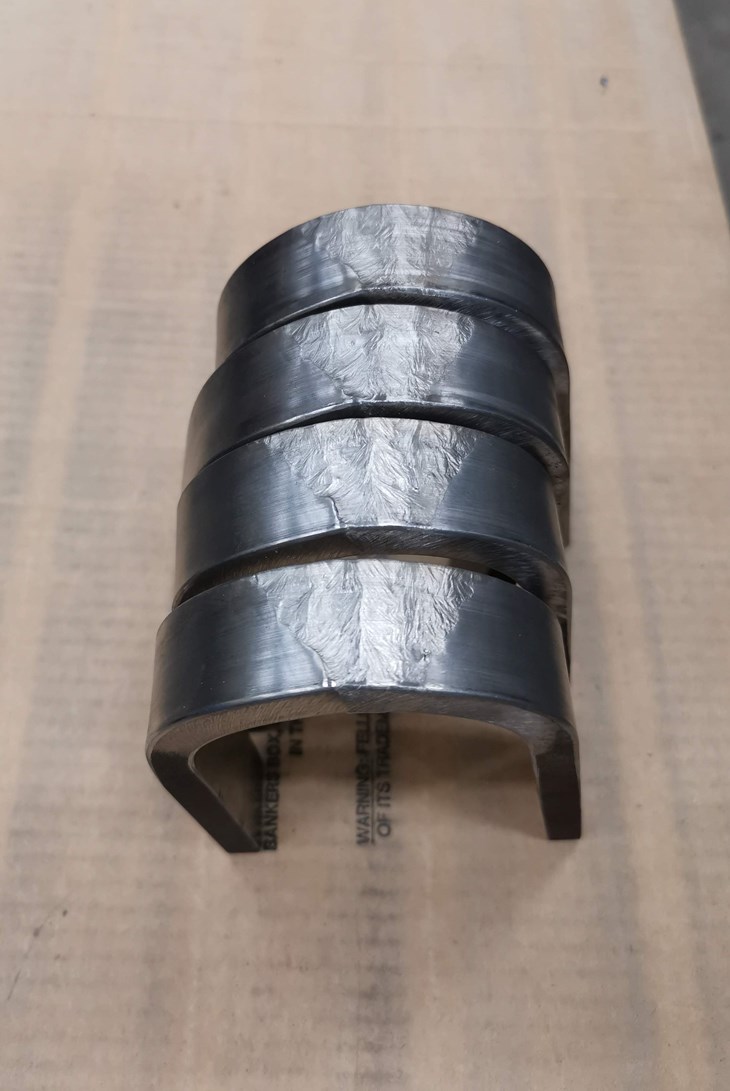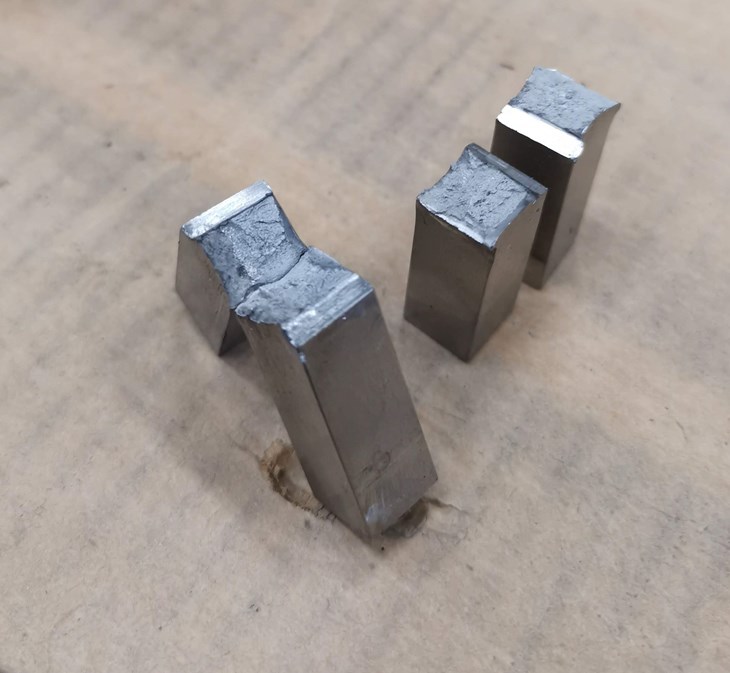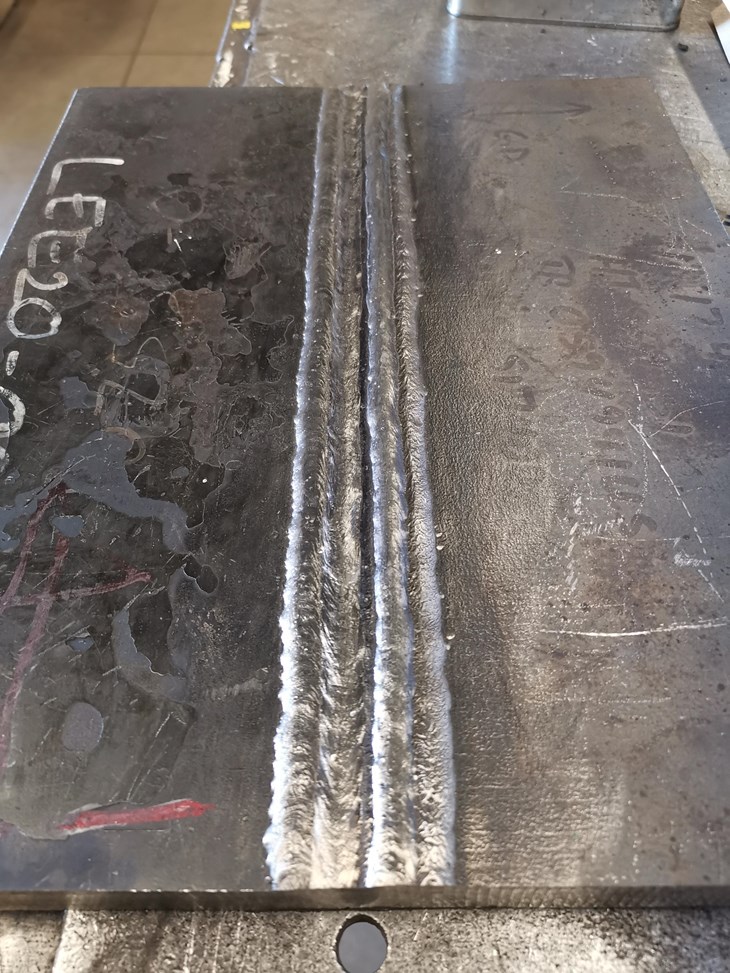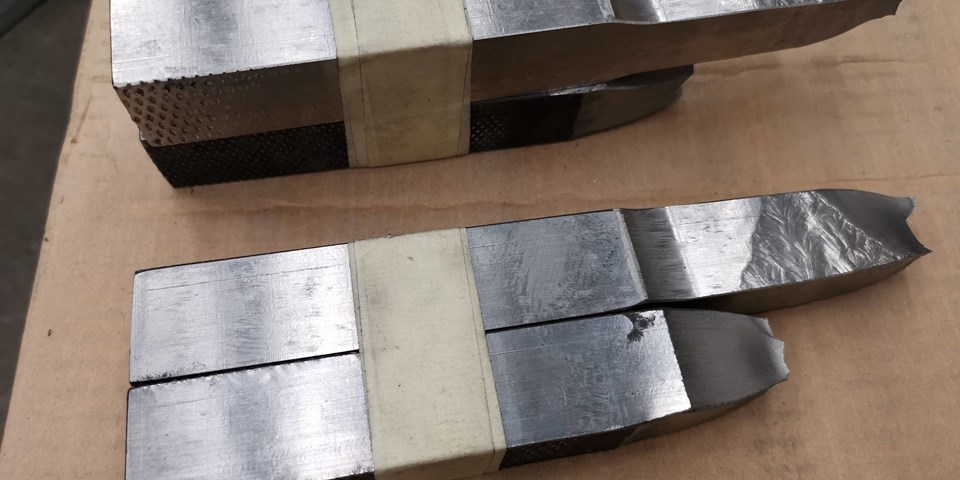The 17-4 PH stainless steel was chosen primarily for its high hardness capability while also being relatively resistant to cracking; the application would be in a rolling situation subject to wear. It may be debated whether ASME Section IX was the most appropriate code to use, however, the testing that would have been conducted would not have changed by using a different code.
By Justin Bekker, Metallurgical & Welding Engineer, SGS Canada Inc.
Preliminary welding consultation
Initially, the client specified that the material to be used in production would be in the H1150D heat treatment condition (held at 1,150°F [621°C] for a double cycle of four hours). Planning was carried out (along with a preliminary heat treatment and tensile test) to develop the WPS (welding procedure specification) in this condition. However, once the results of the tensile test were reviewed, they were deemed unacceptable by the client. It eventually became clear that the client was not familiar with how the precipitation hardening worked.
The material starts in the soft, annealed condition and then is heat treated to increase the hardness, but ‘hotter’ does not necessarily equal ‘harder’. If precipitation hardening treatments between H900 (900°F [480°C] for four hours) and H1150D are considered, the material gets progressively softer from H900 to H1150D.
After this conversation, the client had an internal discussion and a minimum ultimate tensile strength of 1,000 MPa and minimum hardness of 32 HRC were specified. From these requirements, an H1075 condition (held at 1,075°F [580°C] for four hours) was specified. In addition, it was suggested that production material be sourced in the annealed condition so that the result (after stress relieving/precipitation hardening) would meet the client’s requirements. If the material is welded in the hardened condition the risk of cracking increases. After the post weld stress relieving treatment, the 17-4 PH material will further soften from the H1075 condition.
A test piece of base material was heat treated at 580°C for four hours and then tensile tested, which met the requirements of the SA 693 material.
The welding process was to be FCAW (flux-cored arc welding) or MCAW (metal-cored arc welding) for efficiency reasons, and since the 17-4 PH would be joined to a carbon steel, a 309L filler metal was deemed appropriate. After several datasheets were reviewed, an EC309L (MCAW) wire was chosen along with the manufacturer’s recommended gas of 98% Ar/2% CO2.

Welding
A 25mm thick by 400mm long coupon was welded joining one plate of 17-4 PH to one plate of SA 516 in a single V configuration with a backing bar being used. ASME Section IX is very flexible in its qualifications, and this joint would qualify any other joint in any welding position. The production joints were anticipated to be a partial penetration single bevel and a tee fillet welded in the 1G rolled position.
The welding amperages and voltages followed the manufacturer’s recommendations, and the recommended preheat and interpass temperature, and heat inputs were provided. The SA 516 material governed the preheat requirements, which were specified to be 38°C. The 17-4 PH governed the maximum interpass temperature, which was specified to be 120°C. Higher interpass temperatures could lead to cracking due to the high level of strain from the whole weld transforming from austenite to martensite in a single cooling cycle.
The heat input target was 2.5 kJ/mm, however, sometimes targets (particularly heat inputs) are difficult to hit when carrying out PQRs (procedure qualification records), as the welder may speed up or slow down depending on how the passes fit the joint geometry. It may be appropriate to grind out a pass if it is fast (leading to higher hardness) or slow (leading to higher heat input), but one must also consider how that pass has already effected the material below it. In reality, PQRs are typically performed in a welding shop rather than a laboratory, and the precision reflects that environment. In this case, the highest heat input was 3.0 kJ/mm and it was not removed as sensitization and corrosion were not significant concerns for this joint.
Prior to heat treatment, the coupon was cooled to room temperature, to complete the transformation to martensite. For 25mm thick SA 516 Gr. 70 material, a stress relieving heat treatment is typically performed around 620°C for one hour. In this case, the precipitation hardening treatment of the 17-4 PH material took priority. However, the lower temperature of 580°C for a longer hold time of four hours provided adequate stress relieving for the SA 516 material.

Testing
ASME Section IX only requires tensile and bend tests (and impact toughness tests if required, and they were), but additional supplementary tests comprising a Vickers hardness survey, ferrite testing, and a weld metal chemical analysis were performed to further validate the welding parameters that were used.
Due to the large difference in strength (close to double) between the 17-4 PH and the 309L/SA 516 material, it was essential to conduct the bend tests in a wrap-around jig rather than a three-point bend jig. A wrap-around jig clamps one end of the bend specimen in a vice and then applies pressure on a roller that progresses along the bend. Even with the use of the wrap-around jig, the weld metal near the 17-4 PH experienced a higher level of strain (the weld metal has started to ‘neck’ as it stretches), seen in Figure 1. The relatively high elongation of the austenitic stainless steel weld metal likely had a large contribution in these bends passing.
The tensile tests failed in the SA 516 material, as expected, and at a strength greater than the minimum requirement of SA 516 Gr. 70 (483 MPa).
Charpy V-notch (CVN) tests were used to evaluate the impact toughness of the weld at -40°C. There were no specified energy requirements and, had the values been particularly low, a conversation would have been needed to determine further restrictions on the WPS. The HAZ (heat affected zone) of the 17-4 PH material had the lowest average energy at 65 J for a 10 mm x 10 mm specimen.
The highest hardness values were 384 HV10 in the 17-4 PH (HAZ of the cap pass), 202 HV10 in the weld (root pass), and 232 HV10 in the SA 516 (HAZ of the cap pass).
Ferrite testing resulted in an average ferrite number of 15.4, which is an acceptable level for the prevention of cracking as well as maintaining adequate corrosion resistance.
A chemical analysis of the weld deposit was performed as no certificate of conformance was provided for the electrode/gas combination. The result showed that the weld metal conformed to an ASME A8 weld deposit.

Writing the WPS
With the testing completed and the results acceptable, the WPS was written. Using a 25mm thick weld coupon qualified material thicknesses from 16mm to 50mm, which was the maximum thickness that the client anticipated welding on. SA 516 Gr. 70 is an ASME P-No. 1 Group 2 material, but 17-4 PH is not assigned an ASME P-No., so this WPS was only qualified for 17-4 PH to any P-No. 1 Group 2 material.
In the absence of a P-No., ASME Section IX requires the base material to be specified by a material specification, or its mechanical and chemical properties. In the anticipation of other individuals using this WPS, unfamiliar with the background development, the base material requirements for 17-4 PH were written with extra details. SA 693 Type 630 does not have any specified mechanical requirements in the annealed condition, so MTRs (manufacturer test reports) do not typically include any mechanical values. Instead, capability properties are specified in the H900 condition. The purchaser must choose to accept the material based on this H900 capability value even if they intend to use the material in the H1075 condition, or some other condition.
Due to this, the WPS was written requiring the 17-4 PH material to have an H900 capability equal to the SA 693 Type 630 requirements. Alternatively, the 17-4 PH material may be precipitation hardened in the H1075 condition and tested to verify that it meets that condition’s requirements.
The remainder of the WPS was written mostly in line with the qualification allowances of ASME Section IX.
Final thoughts
The client was pleased with their results using this WPS and substituting 4140 material for 17-4 PH. The weldability of 17-4 PH is generally better than 4140, except for the low interpass temperature required for 17-4 PH, and the hardness in the H1075 condition was higher than the client had been achieving with their 4140 WPS. Lastly, the cracking resistance was improved with the 17-4 PH, which was the driving decision to making the material switch.
About the author
Justin Bekker is a Materials Engineer who graduated with a B.Sc. in Materials Engineering from the University of Alberta. He enjoys his job the most when his clients have problems; it is unfortunate for them, but solving their metallurgical problems is what brings Justin satisfaction in his career. In his free time, Justin heads out to the mountains to climb or telemark (as he would say, free the heal and ski for real).

